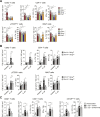Endogenous retroviruses promote homeostatic and inflammatory responses to the microbiota
- PMID: 34166614
- PMCID: PMC8381240
- DOI: 10.1016/j.cell.2021.05.020
Endogenous retroviruses promote homeostatic and inflammatory responses to the microbiota
Abstract
The microbiota plays a fundamental role in regulating host immunity. However, the processes involved in the initiation and regulation of immunity to the microbiota remain largely unknown. Here, we show that the skin microbiota promotes the discrete expression of defined endogenous retroviruses (ERVs). Keratinocyte-intrinsic responses to ERVs depended on cyclic GMP-AMP synthase (cGAS)/stimulator of interferon genes protein (STING) signaling and promoted the induction of commensal-specific T cells. Inhibition of ERV reverse transcription significantly impacted these responses, resulting in impaired immunity to the microbiota and its associated tissue repair function. Conversely, a lipid-enriched diet primed the skin for heightened ERV- expression in response to commensal colonization, leading to increased immune responses and tissue inflammation. Together, our results support the idea that the host may have co-opted its endogenous virome as a means to communicate with the exogenous microbiota, resulting in a multi-kingdom dialog that controls both tissue homeostasis and inflammation.
Keywords: STING; Staphylococcus epidermidis; T cells; antiretroviral; endogenous retrovirus; high fat diet; keratinocytes; microbiota; skin immunity; tissue repair.
Published by Elsevier Inc.
Conflict of interest statement
Declaration of interests Y.B. is a member of the advisory board of the journal Cell.
Figures














Comment in
-
Commensals and immune cells speak in the language of endogenous retroviruses.Cell. 2021 Jul 8;184(14):3593-3594. doi: 10.1016/j.cell.2021.06.013. Cell. 2021. PMID: 34242560
-
Inner viruses ignite immunity to commensals.Nat Rev Immunol. 2021 Aug;21(8):471. doi: 10.1038/s41577-021-00587-y. Nat Rev Immunol. 2021. PMID: 34253905 No abstract available.
References
-
- Banuelos-Sanchez G., Sanchez L., Benitez-Guijarro M., Sanchez-Carnerero V., Salvador-Palomeque C., Tristan-Ramos P., Benkaddour-Boumzaouad M., Morell S., Garcia-Puche J.L., Heras S.R. Synthesis and characterization of specific reverse transcriptase inhibitors for mammalian LINE-1 retrotransposons. Cell Chem. Biol. 2019;26:1095–1109.e14. - PubMed
Publication types
MeSH terms
Substances
Grants and funding
LinkOut - more resources
Full Text Sources
Molecular Biology Databases
Research Materials

